Proclamation Coins 1800
By AG | Monday, 15 September 2003
In late 1800, The Porpoise arrived at Sydney Cove with almost 4 tons (£550 worth) of 1 oz., 1797 dated cartwheel pennies struck by Matthew Boulton. Although not confirmed, it is highly likely that the coins were accompanied by directions from the authorities back in England to rectify the unsatisfactory situation of varying exchange rates for the various coins then circulating in the colony.
In a bid to ensure that the coins were not immediately traded back out, Governor King issued a proclamation which effectively doubled their face value for use in trade within the colony and placed sanctions on their import into or export from the colony. He also took the opportunity to set the values at which other silver and gold coins then in circulation were to trade. These latter valuations were probably in line with valuations derived by the English Treasury and provided for only a small premium above their nominal values.
Governor King's proclamation, which issued on 19th November, 1800 was as follows:
19th Nov. The Currency
WHEREAS Representations of the Want of small money, experienced here, has Induced His Majesty to take into His Gracious Consideration the Immediate relief from this great Inconvenience to all Classes of His Subjects in this Colony, a Quantity of Copper Coin has been received in His Majesty's Armed Vessel 'Porpoise', and will be circulated, by being paid for Grain and Animal Food supplied His Majesty's Stores.
A twopence coin
These are therefore to give notice, that a Copper Coin, weighing One English ounce, and stamped with the profile of His Majesty on the one side, and of Britannia on the other, will be Issued as Above, at the rate of Two pence for each Copper; and that the same shall be paid and pass Current in the Colony, and is to Circulate at the Aforesaid Rate of Two pence.
The legal tender
And that no one may plead Ignorance of the Rate or Legality of this or any other of the Coins circulating in this Colony, of which it does not appear that any regular Proclamation has ever collectively been issued, I have judged it most expedient herewith to publish the following Table of all the specie legally circulating in this Colony, with the Rates Affixed to each, at which they shall be considered, and be a legal tender in all payments or transactions in this Colony.
Table of specie
A Guinea
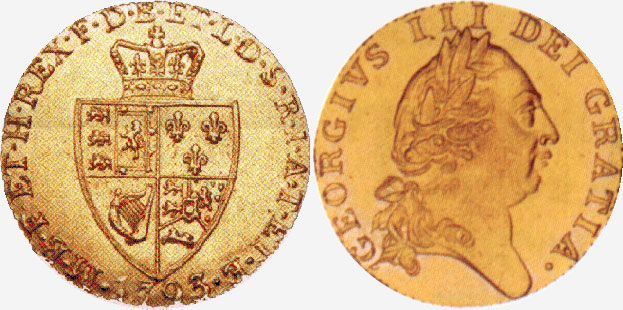
Great Gritain issued guineas in the following reigns & years with the types shown.
- Charles II (1660-1685)
- James II (1685-1688)
- William & Mary (1688-1694)
- William III (1695-1701)
- Anne (1702-1714)
- George I (1714-1727)
- George II (1727-1760)
- George III (1760-1820)
- Square Shield Guinea 1761-1786.
- Spade Shield Guinea 1787-1799.
- Round Shield (Military Type) Guinea 1813.
A Johanna
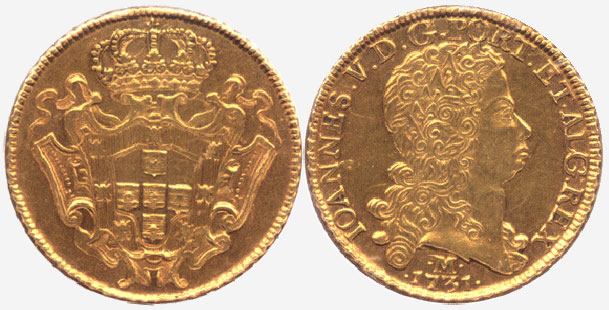
The highest valued of the coins in Governor King's proclamation was Portugal's gold Johanna. Equivalent to 12,800 Reis in Portugal, King gave the coin a value of £4. The coin, struck in 22 carat (.917 fine) gold, weighed 28.68 grams and contained .85 of an ounce of gold. It was struck for a period of only ten years between 1722 and 1732 in the reign of Portugal's John V.
A Half-Johanna
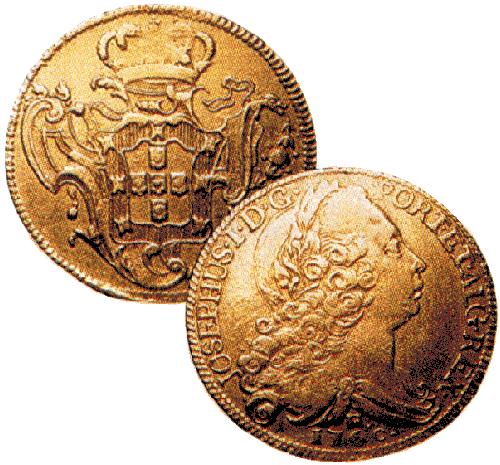
Also included in Governor King's proclamation was Portugal's gold Half Johanna. Equivalent to 6,400 Reis in Portugal, King gave the coin a value of £2. The coin, struck in 22 carat (.917 fine) gold, weighed 14.34 grams and contained .43 of an ounce of gold. While the Johanna was short lived, the Half Johanna was widely used throughout the world.
A Ducat
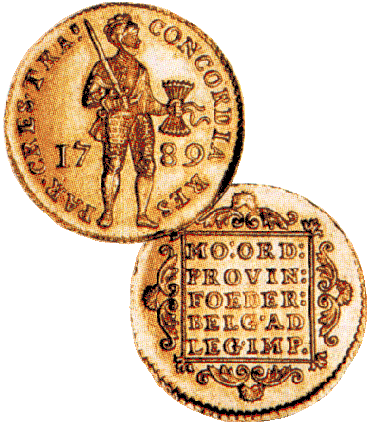
The gold Ducats of the provinces the then Batavian Republic (later to become Holland and finally the Netherlands) were proclaimed by Governor King to have a value of 9 shillings and sixpence. A number of Dutch provinces struck Ducats as trade coinage during their ''Golden Age' as a sea and colonial world power. Machine struck, the .986 fine coins weighed 3.5 grams and each contained .11 ounces of gold.
A Gold Mohur
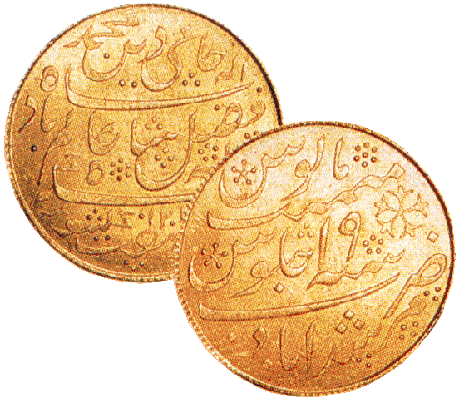
The mohur was the most widely used gold coin on the Indian sub-continent. The denomination was introduced by the Moghul Emperors during the 16th century and over the next two centuries, the mohur was struck with a number of different designs in varying sizes. The most commonly circulating Mohurs at the time of Governor King's proclamation were struck by the British East India Company. King proclaimed them to have a value of £1/17/6 (One pound, seventeen shillings and sixpence). Machine struck between 1790 until 1818, they weighed 12.36 grams and contained almost pure gold - .996 fine.
A Pagoda
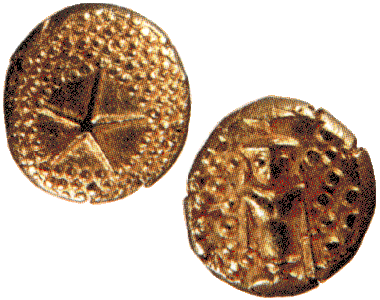
The pagoda was the principal gold coin of Southern India in the late 16th century. Struck by the East India Company, it was a small gold coin which Governor King proclaimed to have a value of 8 shillings. The most famous design was the Star Pagoda, so named for the design appearing on the reverse of the 10 to 11 millimeter diameter coin. Undated, they were struck from 1740 until 1807.
Another Pagoda, also struck throughout the same period, was the Three Swami Pagoda. Slightly larger than the Star Pagoda, it had a diameter of 12 to 14 millimeters and weighed approximately 3.43 grams.
A Spanish Dollar
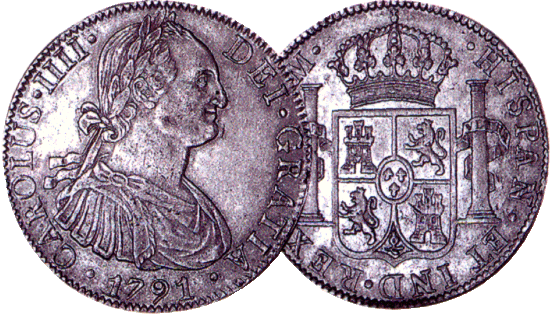
The Spanish Silver Dollar is one of the most famous coins of all time. Also known as 'pieces of eight' (refering to the practice of cutting the coin into eight equal segments), they circulated worldwide as a trade coins. Governor King proclaimed them to have a value of 5 shillings.
A Rupee
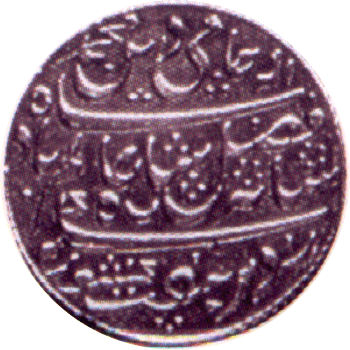
The rupee, known as the 'sicca' rupee (meaning current and widely acceptable), was well known at the time of the proclamation. With a history dating back to the 10th century, and struck throughout India, it was a coin of around 11.69 grams struck in .909 (or higher) silver which Governor King proclaimed to have a value of 2 shillings and sixpence.
A Dutch Guilder
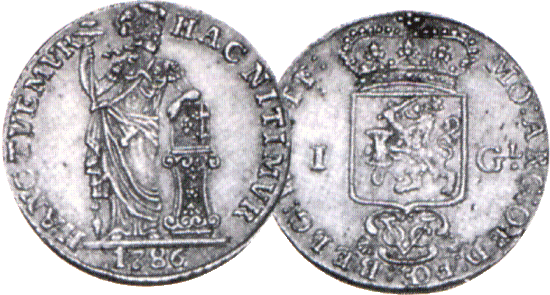
As a legacy of the of the 'golden' sea-faring age of Dutch history, the United Netherlands (Holland) Gulden was a widely circulating silver coin in the 18th and early 19th century. Governor King proclaimed the guilder to have a value of 2 shillings.
An English Shilling
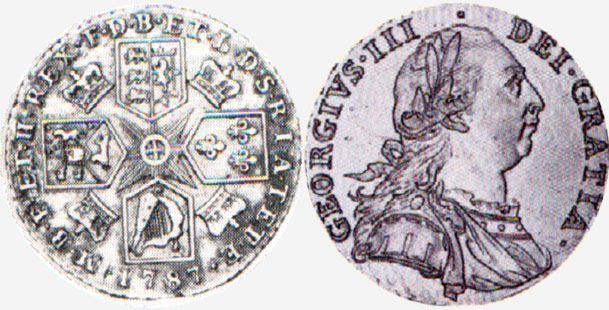
Great Gritain issued shillings (testoons) in the following reigns & years with the types shown.
- Henry VII (1485-1509)
- Henry VIII (1509-1547)
- Edward VI (1547-1553)
- Philip & Mary (1554-1558)
- Elizabeth I (1558-1603)
- James I (1603-1625)
- Charles I (1625-1649)
- Commonwealth - Oliver Cromwell (1649-1660)
- Charles II (1660-1685)
- James II (1685-1688)
- William & Mary (1688-1694)
- William III (1694-1701)
- Anne (1701-1714)
- George I (1714-1727)
- George II (1727-1760)
- George III (1760-1820)
- George IV (1820-1830)
- William IV (1830-1837)
- Victoria (1837-1901)
- Edward VII (1901-1910)
- George V (1910-1936)
- Edward VIII (1936-1937)
- George VI (1937-1952)
- Elizabeth II (1952-)
A Copper Penny of 1 oz
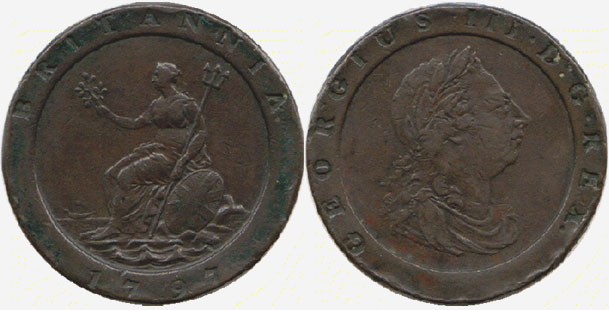
Affectionately known as 'Cartwheels' because of their large size and weight, the 1oz copper penny coin is significant in being the first coin (along with the 2 oz copper twopence) to be produced using Matthew Boulton's steam powered coining press. The coins contained exactly one ounce (avoirdupois) of copper making them ideal as substitutes for weights in measuring produce, a task for which they were intentionally designed.
The coin was given a value of 2 pence by Governor King throughout the infant colony of New South Wales, in his proclamation of 1800.
In 2000, Australia celebrated the bicentenary of King's proclamation by incorporating the 1oz Cartwheel Penny in the design of a special commemorative 1 oz silver coin.
- Obverse: George III - Design by Heinrich Kuchler.
- Legend: GEORGIUS III D G REX
- Reverse: Britannia seated - Design by Heinrich Kuchler.
- Legend: BRITANNIA 1797
- Edge: Plain edge.
- Weight: 28.35 grams.
- Size: 36 mm (diameter).
- Composition: 1 oz Copper.
- Mintmarks: None.
1800, 19th Nov.
When a sufficient quantity of Copper Coin is received in the Colony, of which notice will be given, no private Notes or Cards will be allowed to Circulate.
Copper coin for small amounts only.
This Supply of Copper having been sent to relieve the Inconvenience of persons requiring to make small payments, no persons are to Collect the same for the purpose of making large payments, nor shall it be deemed a legal tender to offer the same in payment for any sum exceeding five pounds.
Coin to be kept in colony.
And it is hereby declared that the Exportation or Importation, except from His Majesty's Treasury, of any sum in Copper exceeding five pounds shall be punished by a Fine of treble the value, and forfeiture of the sum exported or imported.
By this Proclamation of 1800, the values of most of the variety of coins from around the world then in circulation was set for trade within the infant colony of New South Wales. The coins mentioned in the document have come to be known as the 'Proclamation' coins of Australia. They are the first collectable series of coins for the Australian specialist.
On 20 November, 1800, the day after the proclamation was posted on the outer wall of the Government Stores at Sydney and Parramatta, the Royal Admiral arrived at Sydney Cove. On board were boxes of English copper halfpennies and farthings dated 1799.
There is circumstantial, but no confirmed evidence of any official recognition of the value of these newly arrived coins. What is clearly documented however, is that the coins reached the marketplace and traded at twice their nominal value. Most historians and numismatists agree that Governor King hastily added two additional entries to the list of specie in his proclamation - A Copper Coin of Half an Ounce £0 0s 1d, and A Copper Coin of Quarter of an Ounce £0 0s ½d.
By inference, King's proclamation had the effect of placing values on the various sub- and multiple-denominations of each series. For example, the English Guinea was proclaimed at 22/-, therefore the Half Guinea was 11s, the Third Guinea was 7s 4d and the Quarter Guinea was 5s 6d. The copper penny (1 oz), proclaimed at 2d, meant that the halfpenny (½ oz) was 1d and the farthing (¼ oz) was ½d. An example of a multiple was Matthew Boulton's 2oz copper coin with a value of fourpence.
This inference is disputed by some present day historians and numismatists who maintain that only those coins specifically mentioned in the proclamation deserve to be labelled as 'Proclamation Coins'. Naturally, dealers and owners of the fractions and multiples, looking for a profit, take a different point of view.
An example of the traps for present day collectors of the so called 'Proclamation Coins' can be seen in the status accorded to Matthew Boulton's copper penny, halfpenny and farthing coins dated 1806 and 1807. There is no record of another major delivery of English copper coins after the arrival of the Royal Admiral until 1826 when the Brothers delivered £2,010 worth. The following year, the Marquis of Hastings delivered a further £1,000 worth. It was the practice of the English authorities at that time to consign coins to the colonies which had already been widely used and circulated in England. A fair percentage of the coins delivered on the two ships would have been dated 1806 and 1807.
This explains why these coins are often found in building excavations and among our forebears carefully hidden hoardings. Reaching the expanding Sydney Town long after Governor Macquarie's General Order of 1816, the coins are almost certainly not true 'Proclamation Coins' and collectors should be wary of anyone who offers them as such. While all English currency was legal tender in the colony of New South Wales, not all of it was available in the colony during the fifteen years that Governor King's proclamation was in force.
The artificially inflated value of copper coins in the colony could not continue indefinitely. To do so would ensure that profiteers found ways and means to illegally import them. By late 1816, with Holey Dollars and Dumps having been in circulation for a couple of years, the time was right for Governor Macquarie to institute 'a sterling rating for all moneys'.
Macquarie directed his Secretary to issue the following:
Government and General Orders
Government House, Parramatta, Saturday 7th Dec., 1816.
Civil Department.In consideration of the present state and value of the Copper Money now in Circulation, the particular circumstances and periods in and under which the same was heretofore issued, in the necessity of rendering effectual, general and complete, the present establishment and Circulation of Sterling Money, and value only, within this Territory and its' dependencies, His Excellency the Governor is hereby pleased to declare, order, direct and authorize the Deputy Commissary General immediately to receive in payment of exchange for Store Receipts or Government Dollars, at His Majesty's Stores at Sydney, all Copper money now in circulation within this Colony at upon and after the Rate of an advance of 50 per cent on the English Sterling Value, that is to say, to receive or exchange for Sterling and in proportion for and upon the other Denominations of the said Copper Money - provided that the said Copper Money be so tendered for Payments or in Exchange for Sterling Value and amount to the Deputy Commissary General at the stores, between the day for the date of this present Order - and the first day of January next. And provided also that the Copper Money so tendered in payment or exchange be of or before the mintage and date thereon, of the year 1800 when the said Copper Money was so issued by the Government.
And it is hereby further ordered and directed that the said Copper Money shall after the said first day of January next issue, pass current and be paid in circulation within this Territory and its' Dependencie's only upon and at the legal Rate and value of the same specie and coins in England - and further, that it shall not be deemed a legal tender to offer the same in payment of or for any sum exceeding Five Pounds, nor in respect of any Fees or Charges at any Government or Public Office, except at His Majesty's Stores in Sydney, in manner as aforesaid, within this Territory and its Dependencies.
By Command of His Excellency, L T Campbell, Secretary.
To paraphrase this convoluted proclamation, Boulton's copper coins were to trade in the colony at their English values, after a three week change-over period. This effectively ended the valuations made in King's 1800 proclamation.



